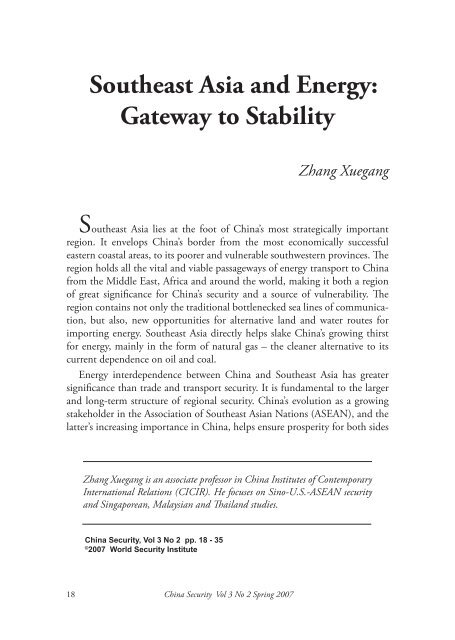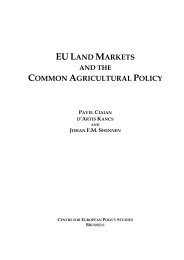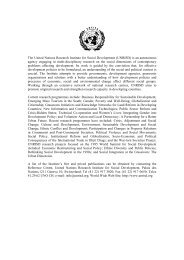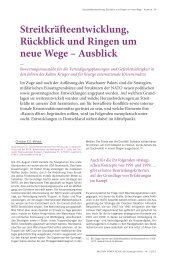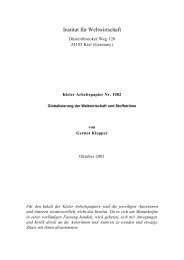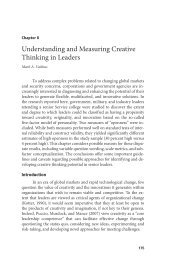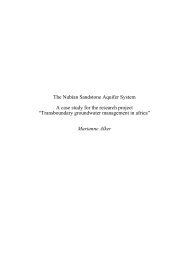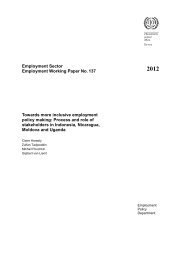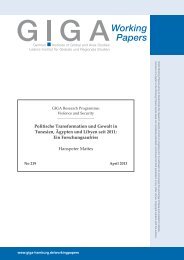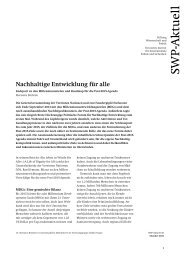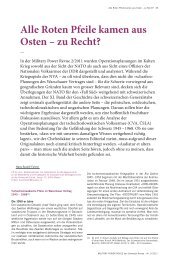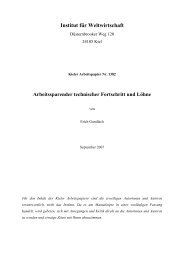Southeast Asia and Energy: Gateway to Stability Zhang Xuegang
Southeast Asia and Energy: Gateway to Stability Zhang Xuegang
Southeast Asia and Energy: Gateway to Stability Zhang Xuegang
You also want an ePaper? Increase the reach of your titles
YUMPU automatically turns print PDFs into web optimized ePapers that Google loves.
18<br />
<strong>Southeast</strong> <strong>Asia</strong> <strong>and</strong> <strong>Energy</strong>:<br />
<strong>Gateway</strong> <strong>to</strong> <strong>Stability</strong><br />
China Security Vol 3 No 2 Spring 2007<br />
<strong>Zhang</strong> <strong>Xuegang</strong><br />
<strong>Southeast</strong> <strong>Asia</strong> lies at the foot of China’s most strategically important<br />
region. It envelops China’s border from the most economically successful<br />
eastern coastal areas, <strong>to</strong> its poorer <strong>and</strong> vulnerable southwestern provinces. The<br />
region holds all the vital <strong>and</strong> viable passageways of energy transport <strong>to</strong> China<br />
from the Middle East, Africa <strong>and</strong> around the world, making it both a region<br />
of great significance for China’s security <strong>and</strong> a source of vulnerability. The<br />
region contains not only the traditional bottlenecked sea lines of communication,<br />
but also, new opportunities for alternative l<strong>and</strong> <strong>and</strong> water routes for<br />
importing energy. <strong>Southeast</strong> <strong>Asia</strong> directly helps slake China’s growing thirst<br />
for energy, mainly in the form of natural gas – the cleaner alternative <strong>to</strong> its<br />
current dependence on oil <strong>and</strong> coal.<br />
<strong>Energy</strong> interdependence between China <strong>and</strong> <strong>Southeast</strong> <strong>Asia</strong> has greater<br />
significance than trade <strong>and</strong> transport security. It is fundamental <strong>to</strong> the larger<br />
<strong>and</strong> long-term structure of regional security. China’s evolution as a growing<br />
stakeholder in the Association of <strong>Southeast</strong> <strong>Asia</strong>n Nations (ASEAN), <strong>and</strong> the<br />
latter’s increasing importance in China, helps ensure prosperity for both sides<br />
<strong>Zhang</strong> <strong>Xuegang</strong> is an associate professor in China Institutes of Contemporary<br />
International Relations (CICIR). He focuses on Sino-U.S.-ASEAN security<br />
<strong>and</strong> Singaporean, Malaysian <strong>and</strong> Thail<strong>and</strong> studies.<br />
China Security, Vol 3 No 2 pp. 18 - 35<br />
© 2007 World Security Institute
<strong>Southeast</strong> <strong>Asia</strong> <strong>and</strong> <strong>Energy</strong>: <strong>Gateway</strong> <strong>to</strong> <strong>Stability</strong><br />
<strong>and</strong> helps channel China’s development in a positive direction. China’s willing<br />
<strong>and</strong> active participation in this process also engenders confidence in its neighbors,<br />
the United States, <strong>and</strong> the rest of the world, as it reveals China’s mutually<br />
beneficial relationship among neighbors. But more than that, it demonstrates<br />
China’s underst<strong>and</strong>ing that other countries dem<strong>and</strong> more than words <strong>and</strong><br />
actions. The constraints of interdependence place confidence in limiting<br />
China’s ambitions, regardless of rhe<strong>to</strong>ric or action. 1 As such, <strong>Southeast</strong> <strong>Asia</strong> is<br />
a ‘gateway’ for China <strong>to</strong> securing a position of regional <strong>and</strong> global influence<br />
while helping <strong>to</strong> maintain strategic stability.<br />
Endowment of Vulnerability<br />
Bounded by Northeast <strong>Asia</strong>, South <strong>Asia</strong> <strong>and</strong> West Pacific, the <strong>Southeast</strong><br />
<strong>Asia</strong>n region contains all the shipping routes for China’s energy importation<br />
<strong>and</strong> transportation from the Middle East, Africa <strong>and</strong> Latin America. There are<br />
at least a dozen strategic straits <strong>and</strong> water bodies in the region including the<br />
Sunda Strait, Gaspar Strait, Lombok Strait, Makassar Strait, Maluku Strait <strong>and</strong><br />
the South China Sea. The most important channel, however, is the Malacca<br />
Strait, primarily because it is the shortest route <strong>to</strong> China (<strong>and</strong> the rest of East<br />
<strong>Asia</strong>) from the Middle East <strong>and</strong> Africa, approximately ,000 km less than the<br />
next fastest route, the Sunda Strait. China is dependent on the Strait for 80<br />
percent of its oil importation <strong>and</strong> estimates predict that China’s oil imports<br />
will grow <strong>to</strong> 00 million <strong>to</strong>ns (per annum) by 010, meaning that China will<br />
only increase its reliance on this sea line in the future. Over half of all vessels<br />
passing through the Strait now head for China, although Japan <strong>and</strong> South<br />
Korea also desperately rely on this waterway for 90 percent <strong>and</strong> 100 percent<br />
respectively of their oil imports. The United States mainl<strong>and</strong> is less reliant on<br />
the Malacca Strait, though its military bases in Guam, Japan <strong>and</strong> South Korea<br />
are dependent on it.<br />
A high dependence on the Malacca Strait leaves China vulnerable not only<br />
<strong>to</strong> threats of piracy <strong>and</strong> terrorism, but also <strong>to</strong> other powerful competi<strong>to</strong>r nations,<br />
including the United States, Japan <strong>and</strong> India, who seek control of these<br />
sea lines <strong>and</strong> who are taking action accordingly. The United States has taken<br />
the lead with a proposal in 00 , the Regional Maritime Security Initiative<br />
(RMSI), which called for the lit<strong>to</strong>ral countries – Singapore, Malaysia <strong>and</strong><br />
Indonesia – <strong>to</strong> permit U.S. Marines <strong>to</strong> patrol against piracy <strong>and</strong> terrorism.<br />
In addition, the Cargo Security Initiative (CSI), established in 001, <strong>and</strong> the<br />
Proliferation Security Initiative (PSI), established in 00 , both involve the<br />
China Security Vol 3 No 2 Spring 2007 19
0<br />
<strong>Zhang</strong> <strong>Xuegang</strong><br />
Malacca Strait region in guarding against transportation of weapons of mass<br />
destruction <strong>and</strong> serve <strong>to</strong> secure international waters. However, RMSI – the one<br />
most directly relevant <strong>to</strong> the narrow shipping lanes – has never been presented<br />
as a mechanism open <strong>to</strong> Chinese or Japanese participation. Coupled with past<br />
experiences, particularly the Yinhe incident of 199 , which is etched deeply<br />
in the Chinese psyche, these initiatives arouse suspicion of U.S. intentions. 6<br />
America’s dominant control of this critical channel would provide it with a<br />
strategic grip on the whole of East <strong>Asia</strong>, an alarmingly vulnerable situation for<br />
China.<br />
Japan <strong>and</strong> India have also taken similar actions <strong>to</strong> increase their control<br />
of the Malacca Strait. In 00 , Japan put forward a security mechanism <strong>to</strong><br />
promote anti-piracy <strong>and</strong> anti-maritime robbery (ReCAAP) by ‘unofficially’<br />
requesting lit<strong>to</strong>ral countries <strong>to</strong> allow the presence of the Japanese Self-Defense<br />
Force. This proposal was refused by <strong>Southeast</strong> <strong>Asia</strong>n countries, mainly because<br />
China Security Vol 3 No 2 Spring 2007
<strong>Southeast</strong> <strong>Asia</strong> <strong>and</strong> <strong>Energy</strong>: <strong>Gateway</strong> <strong>to</strong> <strong>Stability</strong><br />
Japan’s neighbors remain uneasy of its increasing reach in<strong>to</strong> the western Pacific<br />
with their naval power. This resistance will remain as long as Japan’s domestic<br />
politics, influenced by the right, continue <strong>to</strong> deny Japan’s spotted his<strong>to</strong>ry, particularly<br />
in China <strong>and</strong> the Korean Peninsula. The Indian Navy is also revealing<br />
its growing desire <strong>to</strong> be ‘keeper’ of the Strait. Their establishment of military<br />
bases at Andaman Archipelago <strong>and</strong> Nicoba Archipelago at the west end of<br />
the channel – beginning in the 1990s – <strong>and</strong> growing blue water patrolling<br />
capability from the Indian Ocean <strong>to</strong> the South China Sea, demonstrates the<br />
Indian Navy’s ambition. While the implications of these actions by other<br />
states are not entirely clear, China has reason <strong>to</strong> suspect the motives of other<br />
nations, <strong>and</strong> must consider the long-term effects they will have on China’s<br />
energy security.<br />
More Diversity<br />
In recent years, China has taken a number of important steps <strong>to</strong> address<br />
the inherent risks of the Malacca Strait. To begin with, China has actively<br />
developed closer cooperative relationships with Singapore, Malaysia <strong>and</strong><br />
Indonesia, <strong>to</strong> secure China’s interest in the Strait <strong>and</strong> <strong>to</strong> alleviate the growing<br />
rivalries among the world’s major powers. Since 00 , China has played an<br />
active role in maintaining <strong>and</strong> strengthening security in the strait as well as<br />
the prevention of oil leaks in the region. 7<br />
This approach stresses the fact that since<br />
trade <strong>and</strong> energy transport <strong>to</strong> China make<br />
up a majority of the strait’s traffic, sea-lane<br />
security is becoming a core interest <strong>to</strong><br />
China <strong>and</strong> as such, China is pursuing a<br />
leading role in its security. China’s active<br />
engagement in this regard remains via<br />
To minimize its risk,<br />
China is planning on<br />
a diversified energy<br />
transportation strategy.<br />
international cooperation <strong>and</strong> diplomatic efforts. At the same time, this approach<br />
is not unconditional, <strong>and</strong> as the Malacca Strait is of great importance<br />
<strong>to</strong> China’s energy security, China is certainly considering the use of force as<br />
a last option of defense against direct threats – such as a blockade during a<br />
Taiwan crisis.<br />
The potential bottleneck of the Malacca Strait, on which China is overly<br />
dependent for energy <strong>and</strong> trade transport, lends itself easily <strong>to</strong> worst case<br />
scenarios. Therefore, <strong>to</strong> minimize these risks, China is also rigorously planning<br />
for the long term with a diversified transportation strategy that utilizes<br />
China Security Vol 3 No 2 Spring 2007 1
<strong>Zhang</strong> <strong>Xuegang</strong><br />
world-class canal. It would effectively redirect an estimated 90 percent of the<br />
vessels from the Malacca Strait since it would save approximately half the<br />
fuel. 9 Unfortunately, despite enthusiasm within the Thai government, it is<br />
unlikely that progress will be made on the canal in the near future due <strong>to</strong> economic<br />
<strong>and</strong> technical constraints as well as the more recent domestic political<br />
upheaval among Thail<strong>and</strong>’s southern Muslim populations. A more simplified<br />
plan developed in 00 , consisting of roads, rail <strong>and</strong> underground pipelines,<br />
would greatly reduce transport capacity <strong>and</strong> would likely play a significant role<br />
in reducing the current overdependence on the Malacca Strait. 10 Even these<br />
less ambitious plans have been put on hold since the 006 military coup.<br />
In recent years, China <strong>and</strong> Burma have also proposed a plan for building<br />
an oil pipeline. According <strong>to</strong> the scenario, China can build a pipeline from<br />
Sittwe – a city on the southwest coast of Burma near the Indian Ocean – <strong>to</strong><br />
the Chinese city of Kunming in Yunnan Province. This shortcut would reduce<br />
the Malacca voyage by 1 00 km 11 <strong>and</strong> could help relieve China’s dependence<br />
on the Malacca Strait by one-third or more. 1 However, this plan has also<br />
stagnated recently because the Burmese junta worries about being excessively<br />
dependent on exporting oil <strong>to</strong> China <strong>and</strong> is inclined <strong>to</strong> build an alternative<br />
gas pipeline <strong>to</strong>ward China rather than the oil pipeline (the former is a less<br />
China Security Vol 3 No 2 Spring 2007<br />
alternative channels, routes <strong>and</strong><br />
countries <strong>to</strong> import energy <strong>to</strong><br />
China. 8 While such alternatives<br />
create new opportunities for a<br />
sound energy strategy, there are<br />
important limitations that affect<br />
their development <strong>and</strong> functional<br />
capacity in the short term.<br />
The development of a canal<br />
or pipeline across the Isthmus of<br />
Kra in southern Thail<strong>and</strong> would<br />
significantly shift the regional<br />
strategic energy l<strong>and</strong>scape. The<br />
flat terrain, with a minimum<br />
width of 0 km <strong>and</strong> lying mainly<br />
within Thail<strong>and</strong>’s terri<strong>to</strong>ry <strong>and</strong><br />
partially in Burma’s, is ideal for a
sensitive issue). This suggests a current strategy of hedging against China’s<br />
excessive influence as well as Burma’s growing tendency in recent years <strong>to</strong> seek<br />
closer energy cooperation with India. The junta’s decision on this remains in<br />
flux, <strong>and</strong> prospects for a denouement are uncertain.<br />
A third alternative energy transportation route that has been given more attention<br />
is the development of a comprehensive , 00 km trans-<strong>Asia</strong>n railway<br />
network that would link China <strong>to</strong> many ASEAN nations, creating an efficient<br />
means <strong>to</strong> transport energy <strong>and</strong> other goods. Talk of the rail system began in<br />
199 at the th ASEAN Summit <strong>and</strong> the idea has evolved in<strong>to</strong> an elaborate<br />
three-line system that would reduce transportation time <strong>and</strong> costs significantly. 1<br />
The plan is listed in China’s National Plan for Railway Network Constructions<br />
2003-2020, <strong>and</strong> construction is set <strong>to</strong> commence as early as 008. This<br />
network will largely be constructed during the next five <strong>to</strong> 10 years. The trans-<br />
<strong>Asia</strong>n railway network will also build up the infrastructure necessary <strong>to</strong> link<br />
<strong>Southeast</strong> <strong>Asia</strong> <strong>and</strong> China with Northeast <strong>Asia</strong>, Central <strong>Asia</strong>, South <strong>Asia</strong>, <strong>and</strong><br />
eventually create a trans-Eurasian<br />
railway system that would connect<br />
<strong>Asia</strong> <strong>and</strong> Europe. 1 However,<br />
a number of problems plague<br />
this endeavor. For example, Laos<br />
lacks the railway infrastructure <strong>to</strong><br />
effectively participate in the plan<br />
<strong>and</strong> the different rail diameters<br />
used in various ASEAN countries<br />
will prove an additional technical<br />
hurdle. 1 With a price tag of $11<br />
billion USD, however, a shortage<br />
of committed investment remains<br />
the primary obstacle.<br />
Clean <strong>Energy</strong> Prospects<br />
While oil resources in <strong>Southeast</strong><br />
<strong>Asia</strong> are minimal compared <strong>to</strong><br />
those in the Middle East, Africa<br />
<strong>and</strong> Latin America, 16 the region<br />
has collectively become the fourth<br />
largest liquid natural gas (LNG)<br />
<strong>Southeast</strong> <strong>Asia</strong> <strong>and</strong> <strong>Energy</strong>: <strong>Gateway</strong> <strong>to</strong> <strong>Stability</strong><br />
China Security Vol 3 No 2 Spring 2007
<strong>Zhang</strong> <strong>Xuegang</strong><br />
producer, which offers China an important opportunity <strong>to</strong> increase natural<br />
gas in its energy mix. China’s declaration <strong>to</strong> shift from heavily polluting, oilbased<br />
energy consumption <strong>to</strong> cleaner gas-based alternatives is expressed in<br />
their 00 <strong>Energy</strong> <strong>and</strong> Economic Transformation Strategy. This long-term<br />
goal places energy cooperation between <strong>Southeast</strong> <strong>Asia</strong> <strong>and</strong> China at the heart<br />
of the relationship, which was born from the strategic energy partnership that<br />
China <strong>and</strong> ASEAN initiated in 00 . 17 This mechanism was upgraded <strong>to</strong><br />
include cooperation on energy security in the Joint Declaration, released in<br />
January 007. 18<br />
These trends have been underscored by joint surveys, exploration <strong>and</strong> purchases<br />
of gas throughout <strong>Southeast</strong> <strong>Asia</strong>. China Offshore Oil Corporation,<br />
a Chinese state-owned energy corporation, bought a 17 percent stake in<br />
the Tangguh natural gas field, becoming the largest outside inves<strong>to</strong>r in the<br />
industry. In 006, both Indonesia <strong>and</strong> Malaysia won bids for Zhujiang Delta<br />
<strong>and</strong> Shanghai Delta LNG projects, respectively. 19 China, the Philippines,<br />
<strong>and</strong> Vietnam also signed a working agreement for joint surveys in the South<br />
China Sea in 00 , which led <strong>to</strong> cooperation on a previously hotly disputed<br />
region. 0<br />
Thail<strong>and</strong> <strong>and</strong> Burma are also important players in the natural gas industry<br />
in the region. 1 Currently, Thail<strong>and</strong>’s gas exports <strong>to</strong> China account for half<br />
( 0,000 <strong>to</strong>ns) of Thail<strong>and</strong>’s <strong>to</strong>tal LNG exportation, making up about<br />
percent of China’s imports. According <strong>to</strong> Burma’s energy companies, their<br />
resources exceed 1. trillion m of natural gas <strong>and</strong> they currently extract<br />
billion m of that per year. If the gas pipeline comes in<strong>to</strong> service by 010, it<br />
will provide much larger proportion of China’s imports than Thail<strong>and</strong>. China<br />
began <strong>to</strong> make joint explorations with Burma in 001, <strong>and</strong> in 00 , Burma<br />
allowed China <strong>to</strong> explore deep-water areas off its coast in the Indian Ocean.<br />
<strong>Stability</strong> in China’s Backyard<br />
China’s evolving relationship with <strong>Southeast</strong> <strong>Asia</strong> goes beyond a simple<br />
interest in energy cooperation. <strong>Southeast</strong> <strong>Asia</strong> geographically bounds China <strong>to</strong><br />
the south <strong>and</strong> west, all of which are extremely important for China’s continued<br />
economic stability <strong>and</strong> growth, from the booming coastal regions <strong>to</strong> the<br />
poorer <strong>and</strong> more vulnerable southwestern provinces of Yunnan, Hainan <strong>and</strong><br />
Guangxi. Burma is a particularly vivid case in point. Minority groups lie on<br />
both sides of the long border shared by Burma <strong>and</strong> China, <strong>and</strong> some groups<br />
on Burma’s side have their own armed militias (Shan State). Maintaining a<br />
China Security Vol 3 No 2 Spring 2007
<strong>Southeast</strong> <strong>Asia</strong> <strong>and</strong> <strong>Energy</strong>: <strong>Gateway</strong> <strong>to</strong> <strong>Stability</strong><br />
working relationship with the junta <strong>and</strong> the country’s neighboring regions is<br />
essential <strong>to</strong> maintaining stability. A volatile situation in Burma could overflow<br />
in<strong>to</strong> China’s own delicate ethnic balance <strong>and</strong> would surely entail a large flood<br />
of refugees in<strong>to</strong> bordering Chinese terri<strong>to</strong>ries, an area that is already economically<br />
lagging. Engagement with<br />
the junta is not <strong>to</strong> ignore or accept<br />
its repressive ways but, considering<br />
China’s own social, economic <strong>and</strong><br />
political balance, it is the path of least<br />
risk, <strong>and</strong> China should not be blamed<br />
for pursuing it. This path also st<strong>and</strong>s<br />
the best chance for compelling Burma’s junta <strong>to</strong> spend energy dividends in a<br />
way that improves the lives of its disaffected citizens <strong>and</strong> continue <strong>to</strong>ward a<br />
democratic process.<br />
China’s energy relations with Indonesia <strong>and</strong> Malaysia, which helps spur<br />
other areas of trade, also provide an important platform for changing his<strong>to</strong>rically<br />
hostile attitudes <strong>to</strong>ward China – most recently expressed through<br />
the anti-Chinese riots of 1998. <strong>Energy</strong> deals have percolated down <strong>to</strong> greater<br />
maritime security cooperation. Such measures can only build trust <strong>and</strong> confidence<br />
<strong>and</strong> improve the safety of the Chinese Diaspora in these countries.<br />
Terri<strong>to</strong>rial disputes between China, the Philippines <strong>and</strong> Vietnam in the<br />
South China Sea have even led <strong>to</strong> armed conflict in the past. However, a<br />
new direction for laying aside these differences <strong>and</strong> joining h<strong>and</strong>s in exploration<br />
of the South China Sea began in 1986 <strong>and</strong> culminated in a code of<br />
conduct in 00 . Since then, China has vastly improved its relations <strong>and</strong><br />
image with ASEAN, particularly with regard <strong>to</strong> the Philippines <strong>and</strong> Vietnam,<br />
who his<strong>to</strong>rically have had an uneasy relationship with China. Joint energy<br />
exploration projects have resulted from the recovering cooperation <strong>and</strong> have<br />
served <strong>to</strong> strengthen ties. These include the first agreement between China<br />
<strong>and</strong> the Philippines on energy exploration signed in 00 <strong>and</strong> a second joint<br />
survey agreement in 00 . First-time negotiations have also begun with the<br />
Vietnamese for joint exploration over disputed areas in the South China Sea<br />
at the 11 th intergovernmental meeting in late 00 . China <strong>and</strong> Vietnam also<br />
began their first joint patrol over the Gulf of Tonkin in 006 <strong>and</strong> later in the<br />
year, the Chinese Coast Guard rescued 100 Vietnamese fisherman caught in a<br />
typhoon. The three countries are now discussing further security cooperation<br />
China Security Vol 3 No 2 Spring 2007<br />
China’s evolving relationship<br />
with <strong>Southeast</strong> <strong>Asia</strong> goes<br />
beyond energy cooperation.
6<br />
<strong>Zhang</strong> <strong>Xuegang</strong><br />
in the South China Sea against piracy, smuggling <strong>and</strong> transnational crime.<br />
The Isthmus of Kra is also more than a mere alternative passage-way <strong>to</strong><br />
the Malacca Strait for energy imports <strong>to</strong> China. It can also provide a useful<br />
strategic seaway for international navies in the <strong>Asia</strong>n-Pacific region. In this<br />
function, it could also provide a strategic seaway <strong>to</strong> the Chinese navy. As a<br />
result of improving relations between the two countries, the Thai navy has<br />
already begun <strong>to</strong> purchase hardware upgrades including Chinese-made warships.<br />
Through the Isthmus, Chinese fleets could also more easily protect the<br />
nearby sea-lanes <strong>and</strong> gain access <strong>to</strong> the Indian Ocean.<br />
Progress in various areas with many of the ASEAN countries is not <strong>to</strong> deny<br />
that significant challenges still lie ahead. The lit<strong>to</strong>ral countries of the South<br />
China Sea continue <strong>to</strong> make efforts <strong>to</strong> secure their occupied isl<strong>and</strong>s <strong>and</strong> reefs<br />
as well as build new airports with military uses. Fishing conflicts in exclusive<br />
economic zones continue <strong>to</strong> flare up from time <strong>to</strong> time. However, in light of<br />
the vastly improved energy, economic, political <strong>and</strong> even security cooperation,<br />
the trend of Sino-<strong>Southeast</strong> <strong>Asia</strong>n relations is distinctly moving upward.<br />
The Ties That Bind<br />
A Chinese proverb states that “two grasshoppers bound by one rope” share<br />
a destiny, because any action of the one affects the other. In that sense, China<br />
<strong>and</strong> <strong>Southeast</strong> <strong>Asia</strong> are two ‘grasshoppers’ bound <strong>to</strong>gether by their growing<br />
interdependence; the ties are political, economic, cultural <strong>and</strong> strategic, <strong>and</strong><br />
are manifested in a number of ways. In political terms – despite a lack of<br />
efficiency that sometimes plagues regional discussions – multilateralism <strong>and</strong><br />
non-interference are emphasized, which require compromise, accommodation<br />
<strong>and</strong> consensus between all countries. Economically, these countries prefer<br />
unconditional cooperation that emphasizes a practical, mutually-beneficial<br />
approach, as opposed <strong>to</strong> the values <strong>and</strong> principles that condition Western<br />
countries’ international relations. This is not <strong>to</strong> suggest the ‘<strong>Asia</strong>n way’ lacks<br />
principle, but rather, for his<strong>to</strong>rical <strong>and</strong> other reasons, it holds <strong>to</strong> different<br />
values. Cultural ties have their limitations, but the region shares more similarities<br />
within itself <strong>and</strong> China than it does with any other region, including the<br />
Middle East, Africa or the Americas. Most ASEAN countries not only share<br />
Chinese culture, but many have very large, resident ethnic Chinese groups<br />
that date far back in his<strong>to</strong>ry. With respect <strong>to</strong> shared security goals, the ASEAN<br />
countries do not want <strong>to</strong> confront or align themselves with big powers (China<br />
included) partly because they don’t have the power <strong>to</strong> do so <strong>and</strong> partly because<br />
China Security Vol 3 No 2 Spring 2007
<strong>Southeast</strong> <strong>Asia</strong> <strong>and</strong> <strong>Energy</strong>: <strong>Gateway</strong> <strong>to</strong> <strong>Stability</strong><br />
their lowest risk strategy is <strong>to</strong> maintain a balance among the giant powers.<br />
Even non-traditional security plays a crucial role in binding the two regions<br />
<strong>to</strong>gether, including the management of avian flu, environmental disasters,<br />
combating drug trafficking, etc. More than any other fac<strong>to</strong>r, however, it is<br />
energy – including China’s dependency on the Strait of Malacca <strong>and</strong> other<br />
alternative routes – <strong>and</strong> cooperation in exploration <strong>and</strong> imports that is the<br />
driving force behind China’s growing interconnectedness with <strong>Southeast</strong> <strong>Asia</strong>.<br />
This is so because energy is the most prominent element that links economic,<br />
political <strong>and</strong> security considerations between the two sides.<br />
More important than these natural affinities <strong>and</strong> cooperative links is the<br />
fact that China binds itself willingly, even actively, <strong>to</strong> <strong>Southeast</strong> <strong>Asia</strong>. This is<br />
best illustrated by China’s preference <strong>to</strong> maintain a prominent <strong>and</strong> active role<br />
in the region through comprehensive means, rather than particularly political<br />
or military measures that could cause more friction. The Peace, Wealth <strong>and</strong><br />
<strong>Stability</strong> Pact with ASEAN countries, initiated by China in 00 , created a<br />
strategic partnership within the region <strong>and</strong> built respect for China among<br />
the ASEAN countries, illustrated by Philippine President Gloria Macapagal-<br />
Arroyo’s praise – without irony – that<br />
“China is the big brother <strong>to</strong> ASEAN.”<br />
Economically, China has pushed along<br />
the free trade mechanisms with ASEAN,<br />
leading eventually <strong>to</strong> the China-ASEAN<br />
Free Trade Agreement (FTA), which will become<br />
the third largest FTA after the North<br />
China binds itself<br />
willingly, even actively,<br />
<strong>to</strong> <strong>Southeast</strong> <strong>Asia</strong>.<br />
American Free Trade Agreement <strong>and</strong> that between EU countries. This augurs<br />
well for <strong>Asia</strong>n economic security <strong>and</strong> growth. In addition, China's ongoing<br />
investments in many local energy projects within the more underdeveloped<br />
countries of <strong>Southeast</strong> <strong>Asia</strong> may help <strong>to</strong> ensure citizens of ASEAN countries<br />
a more prosperous future. In short, China has gradually grown in<strong>to</strong> a willing<br />
stakeholder, transforming from an outsider <strong>to</strong> an insider.<br />
At the same time, <strong>Southeast</strong> <strong>Asia</strong>n countries have recognized China’s stabilizing<br />
role in the region <strong>and</strong> have also consciously bound themselves tighter<br />
with China. The most powerful proof for this is the fact that China has experienced<br />
a substantial trade increase with ASEAN beginning in 1997, which<br />
has greatly favored the latter in terms of a trade balance. China’s trade deficit<br />
<strong>to</strong>ward ASEAN jumped from $ .8 billion USD in 000 <strong>to</strong> $19.6 billion USD<br />
China Security Vol 3 No 2 Spring 2007 7
in 00 . In essence, ASEAN has hugely benefited from China over the last<br />
10 years. China’s steadying h<strong>and</strong> <strong>and</strong> contribution <strong>to</strong> economic growth in<br />
the region is in sharp contrast <strong>to</strong> the harsh criticism coming from the United<br />
States over China’s economic policies.<br />
These trends have done much <strong>to</strong> ameliorate the concerns about the ‘China<br />
threat’ that is emanating from other parts of the world. China’s decision <strong>to</strong><br />
bind itself <strong>to</strong> <strong>Southeast</strong> <strong>Asia</strong> goes beyond rhe<strong>to</strong>ric <strong>and</strong> action. The interdependencies<br />
within political, economic, security <strong>and</strong> energy frameworks are<br />
creating structural connections that promote trust, confidence <strong>and</strong> mutual<br />
reliance that inherently relieve <strong>Southeast</strong> <strong>Asia</strong>n<br />
fears of the 00-pound gorilla in their midst.<br />
Furthermore, these ties are in effect creating<br />
strategic constraints. Continued talk of China’s<br />
rise as being ‘peaceful’, will only convince others<br />
<strong>to</strong> a limited degree. Rather, perceptions rooted<br />
in structural <strong>and</strong> irreversible economic <strong>and</strong><br />
security mechanisms will carry far more weight than words, <strong>and</strong> both ASEAN<br />
<strong>and</strong> China have a mutual underst<strong>and</strong>ing of this concept. This intertwining<br />
of fates, as it were, is a new security concept <strong>and</strong> is effectively transforming<br />
China’s soft power <strong>and</strong> influence in the region <strong>and</strong> beyond.<br />
Put in the context of China’s changing long-term strategic needs, China’s<br />
full <strong>and</strong> active engagement in the region is part of a larger consideration that<br />
goes <strong>to</strong> the heart of its national strategy – China’s ‘peaceful rise’ or ‘peaceful<br />
development’. This slogan is often unders<strong>to</strong>od more as an active goal, but it<br />
is also a description of an inevitable trend, an economic <strong>and</strong> strategic reality.<br />
While China’s continued rise will eventually extend beyond the region, the<br />
most viable method <strong>to</strong> ensuring that it occurs in a peaceful way is for China <strong>to</strong><br />
prove its benign intentions <strong>to</strong> the region first. This will lead <strong>to</strong> a critical mass<br />
of ‘structural’ soft power <strong>and</strong> influence as described above, which will hopefully<br />
spill over beyond the region <strong>and</strong> <strong>to</strong> other parts of the world. 6 <strong>Southeast</strong><br />
<strong>Asia</strong> is currently described as a ‘gateway’ for China. This is true in a literal<br />
sense, as <strong>Southeast</strong> <strong>Asia</strong> is a necessary passageway for China’s commercial trade<br />
<strong>and</strong> energy imports, but it is also true in a figurative sense, as <strong>Southeast</strong> <strong>Asia</strong> is<br />
the ‘gateway’ <strong>to</strong> shaping the belief in China’s peaceful rise both in <strong>and</strong> beyond<br />
the region.<br />
<strong>Southeast</strong> <strong>Asia</strong> can<br />
be described as a<br />
‘gateway’ for China.<br />
8<br />
<strong>Zhang</strong> <strong>Xuegang</strong><br />
China Security Vol 3 No 2 Spring 2007
<strong>Southeast</strong> <strong>Asia</strong> <strong>and</strong> <strong>Energy</strong>: <strong>Gateway</strong> <strong>to</strong> <strong>Stability</strong><br />
Unlikely Exceptions<br />
China’s conscious strategy of a peaceful <strong>and</strong> mutually constraining rise is<br />
not unconditional. The use of non-peaceful means cannot be ruled out <strong>and</strong><br />
would be conceivable under only one or two remotely possible scenarios, one<br />
being the public <strong>and</strong> formal declaration of Taiwan’s independence <strong>to</strong> the international<br />
community. In this case, China would have <strong>to</strong> resort <strong>to</strong> force under<br />
the anti-secession law. The difficult question is whether <strong>Southeast</strong> <strong>Asia</strong> would<br />
fac<strong>to</strong>r in <strong>to</strong> any conflict that involved Taiwan. This is particularly pertinent<br />
because such a scenario would almost invariably entail an embargo on China’s<br />
energy <strong>and</strong> trade routes; that is, the Malacca Strait <strong>and</strong> other sea lanes of<br />
communication.<br />
Drawing out the framework for such an event <strong>and</strong> what China’s specific<br />
response would be is beyond the scope of this paper; however, there are important<br />
notes <strong>to</strong> stress. On the one h<strong>and</strong>, China can <strong>and</strong> will act <strong>to</strong> defend<br />
its interests in this regard, including the appropriate use of force in <strong>Southeast</strong><br />
<strong>Asia</strong>, though that would be circumscribed by the extent <strong>to</strong> which the region<br />
was embroiled in such a conflict. China possesses the capability, through surface<br />
<strong>and</strong> subsurface naval capabilities as well as its short- <strong>and</strong> medium-ranged<br />
conventional missiles, <strong>to</strong> achieve such goals from the Taiwan Strait <strong>to</strong> the<br />
Malacca Strait. On the other h<strong>and</strong>, <strong>and</strong> importantly so, China will only do so<br />
in response <strong>to</strong> the region’s entanglement in such a conflict <strong>and</strong> will not preemptively<br />
use force in the strait or the region <strong>to</strong> secure a military advantage.<br />
The distinction is important <strong>and</strong> points <strong>to</strong> the fact that China views Taiwan’s<br />
status as its core national interest <strong>and</strong> will protect that interest at all cost, <strong>and</strong><br />
secondly, any military conflict over a declaration of Taiwanese independence<br />
will be defensive in nature <strong>and</strong> will be pursued with purely defensive objectives.<br />
These strategic scenarios readily lend themselves <strong>to</strong> escala<strong>to</strong>ry updrafts,<br />
where Taiwan, the United States <strong>and</strong> China would all lose in many ways,<br />
making the likelihood of such a conflict nearly inconceivable.<br />
The second possible scenario is a limited conflict involving the Malacca<br />
Strait (though not Taiwan); however, primarily two deterrents work against<br />
any such scenario. The first is China’s deep interests in the sea-lanes <strong>to</strong> secure<br />
safe passage of its energy <strong>and</strong> commerce cargo. As such, China would employ<br />
force against any military threats <strong>to</strong> those interests. However, China would<br />
not consider control over the strait in such a scenario as a core national inter-<br />
China Security Vol 3 No 2 Spring 2007 9
0<br />
<strong>Zhang</strong> <strong>Xuegang</strong><br />
est <strong>and</strong> as such, the guiding principle in such an event would be limited <strong>to</strong><br />
a regional conflict, not ‘<strong>to</strong>tal war.’ The second deterrent is the mindset of<br />
nearly every <strong>Southeast</strong> <strong>Asia</strong>n nation that has maintained a ‘balancing policy’<br />
or hedging strategy against China, the United States, <strong>and</strong> other major powers<br />
seeking strategic advantage in the region. The United States has his<strong>to</strong>rically<br />
held prominent influence <strong>and</strong> power in the region, both through bilateral alliances<br />
as well as raw naval power. However, <strong>Southeast</strong> <strong>Asia</strong> is also increasingly<br />
reluctant <strong>to</strong> offend China. The joint statement by ASEAN opposing Taiwanese<br />
independence supports this conclusion. In addition, two key countries in the<br />
region, Indonesia <strong>and</strong> Malaysia, are also Islamic states <strong>and</strong> with recent conflict<br />
in the Middle East, the countries have raised their vigilance against the meddling<br />
of outside powers. The formation of MALSINDO in 00 , a security<br />
cooperative mechanism between Malaysia, Singapore <strong>and</strong> Indonesia <strong>to</strong> patrol<br />
the Malacca <strong>and</strong> other straits, excludes others countries such as the United<br />
States.<br />
Partners or Adversaries<br />
The low probability for conflict in the region notwithst<strong>and</strong>ing, the future<br />
prospects for a regional economic <strong>and</strong> security architecture with <strong>Southeast</strong><br />
<strong>Asia</strong> <strong>and</strong> China is naturally the object of intense concern <strong>to</strong> the other principal<br />
interested party in the western Pacific: the United States. Those concerns can<br />
be boiled down <strong>to</strong> two main questions: first, are the mutual ties <strong>and</strong> constraints<br />
through economic, political <strong>and</strong> security mechanisms able <strong>to</strong> maintain<br />
a stable strategic environment in the region, <strong>and</strong>, if so, is that kind of close<br />
interdependent relationship beneficial or harmful <strong>to</strong> U.S. interests?<br />
Naturally, a constructive outcome of the interaction between China <strong>and</strong><br />
<strong>Southeast</strong> <strong>Asia</strong> cannot be predicted with any certainty. However, powerful<br />
forces of energy security, economic growth, globalization, <strong>and</strong> a natural resistance<br />
<strong>to</strong> China’s rise by its neighbors are powerful elements that should point<br />
<strong>to</strong> such a conclusion. But rationales have limited value, <strong>and</strong> perceptions of<br />
China’s rise as harmful or threatening cannot be discounted. However, China<br />
underst<strong>and</strong>s both regional <strong>and</strong> global anxieties <strong>and</strong> is working <strong>to</strong> close the<br />
loop of rhe<strong>to</strong>ric, action <strong>and</strong> structural realities that will make a benign strategic<br />
environment a reality.<br />
The United States has little objective cause for worry about China’s unique<br />
relationship with <strong>Southeast</strong> <strong>Asia</strong>. China has officially <strong>and</strong> unofficially expressed<br />
its desire for inclusiveness, not exclusiveness, with regard <strong>to</strong> multilateral coop-<br />
China Security Vol 3 No 2 Spring 2007
<strong>Southeast</strong> <strong>Asia</strong> <strong>and</strong> <strong>Energy</strong>: <strong>Gateway</strong> <strong>to</strong> <strong>Stability</strong><br />
eration in the region, specifically with the United States as China is not looking<br />
<strong>to</strong> challenge U.S. presence or influence in the region. 7 Of course, there is<br />
significant anxiety over what China will do once it becomes more powerful.<br />
However, China is currently quite inferior <strong>to</strong> the United States in terms of<br />
hard power <strong>and</strong> will always have a strong Japanese regional soft power <strong>to</strong><br />
contend with (because of Japan’s formidable economic strength). In addition,<br />
China’s neighboring countries are highly allergic <strong>to</strong> superpower resurgence<br />
in the region since the end of the Cold War <strong>and</strong> will always look <strong>to</strong> balance<br />
their interests between China <strong>and</strong> other global powers. Most importantly, it<br />
should not be overlooked that China’s of-<br />
ficial commitment <strong>to</strong> develop peacefully is<br />
not a casual claim. China underst<strong>and</strong>s its China is not looking <strong>to</strong><br />
strategic environment <strong>and</strong> has taken the challenge U.S. presence<br />
lessons of his<strong>to</strong>ry <strong>to</strong> heart. In short, China<br />
or influence in the region.<br />
has elected <strong>to</strong> pursue its interests <strong>and</strong> goals<br />
through the comprehensive means of politics,<br />
economics, diplomacy <strong>and</strong> culture, rather than primarily political pressure<br />
<strong>and</strong> military coercion. China’s military <strong>and</strong> hard power is not insignificant<br />
<strong>and</strong> it will grow, but China has demonstrated its intent <strong>to</strong> use its position <strong>to</strong><br />
join in the international regime <strong>to</strong> defend against non-traditional crises such<br />
as curbing bird flu, transnational crimes, piracy <strong>and</strong> drug trafficking, <strong>and</strong> <strong>to</strong><br />
protect the international market system – with universal access <strong>to</strong> energy as an<br />
important component.<br />
Distrust <strong>and</strong> differences in interest will continue <strong>to</strong> plague the relationship<br />
of all the major players in <strong>Southeast</strong> <strong>Asia</strong>. China’s unpleasant memories of the<br />
Yinhe incident will continue <strong>to</strong> dictate its resistance <strong>to</strong> the Proliferation Security<br />
Initiative, Cargo Security Initiative <strong>and</strong> <strong>Asia</strong>n Security Conference (Shangri-La<br />
Dialogue [SLD]), particularly if left unchanged. However, an exp<strong>and</strong>ed RMSI<br />
that would include China certainly seems <strong>to</strong> be favorable <strong>to</strong> China. This may<br />
be politically difficult in the United States, <strong>and</strong> so a multinational coast guard<br />
<strong>to</strong> patrol these waters, most likely under the auspice of a UN peacekeeping<br />
mission, should be operationally <strong>and</strong> even politically feasible. Such a mechanism<br />
should be acceptable <strong>to</strong> China <strong>and</strong> the United States as well as for Japan<br />
<strong>and</strong> India. However, the lit<strong>to</strong>ral states are key <strong>to</strong> any solution <strong>and</strong> China <strong>and</strong><br />
the United States must think creatively <strong>to</strong> form a mechanism for maritime<br />
cooperation in the Malacca Strait based on mutual benefits <strong>and</strong> interests. This<br />
could either be established under a Malacca Strait Committee, which would<br />
China Security Vol 3 No 2 Spring 2007 1
<strong>Zhang</strong> <strong>Xuegang</strong><br />
be charged with funding, equipping <strong>and</strong> aiding lit<strong>to</strong>ral states <strong>to</strong> patrol the<br />
strait, <strong>and</strong> could include stakeholder participation in the duties of sea-lane<br />
security, in accordance with each country’s proportion of ownership <strong>and</strong> use<br />
of the strait.<br />
In addition, energy cooperation can have indirect effects on the ‘war on<br />
terror’. Together, China <strong>and</strong> the United States could provide support in the<br />
<strong>Asia</strong>-Pacific region <strong>and</strong> ASEAN countries <strong>to</strong> assist with energy transport <strong>and</strong><br />
infrastructure, such as oil <strong>and</strong> gas pipelines as well as roads <strong>and</strong> railways. This<br />
could be accomplished through using the model of the U.S. Peace Corps,<br />
which strives <strong>to</strong> assist underdeveloped nations <strong>and</strong> continues <strong>to</strong> inspire the<br />
international community <strong>to</strong>day. A Peace Corps-like group could assist with<br />
energy (<strong>and</strong> other) infrastructure development <strong>and</strong> could help <strong>to</strong> eliminate<br />
poverty (one of the primary roots of disaffection among Muslims who resort <strong>to</strong><br />
terrorism) in the <strong>Southeast</strong> <strong>Asia</strong>n Islamic world, which is home <strong>to</strong> the world’s<br />
most populous Islamic country with rising insurgencies.<br />
Finally, China <strong>and</strong> the United States have taken important steps forward <strong>to</strong><br />
improving bilateral relations with the Strategic Dialogue Partnership in 00<br />
<strong>and</strong> Strategic Economic Dialogue in 006. High-level dialogues between the<br />
two countries have also been initiated <strong>to</strong> improve collaboration on crucial<br />
issues of global energy supply <strong>and</strong> coordination of energy policies. 8 But, they<br />
are merely policies, which a new administration in 008 can change or even<br />
ab<strong>and</strong>on. Thus, they need <strong>to</strong> be elevated in status <strong>and</strong> at least include a formal<br />
memor<strong>and</strong>um of underst<strong>and</strong>ing. An ‘<strong>Energy</strong> Partnership’ with legal force is<br />
required. From an immediate political perspective, it would benefit the United<br />
States because it would be able <strong>to</strong> negotiate <strong>and</strong> influence the direction of<br />
Chinese energy policies. At a more strategic level, China <strong>and</strong> the United States<br />
are the world’s largest CO emitters <strong>and</strong> their cooperation on this issue is<br />
extremely important <strong>to</strong> their respective economies <strong>and</strong> global security. This<br />
agreement should include the sharing of more clean energy technologies with<br />
China that will both reduce pollution <strong>and</strong> improve energy efficiency with<br />
attendant effects on <strong>to</strong>tal energy dem<strong>and</strong>.<br />
China Security Vol 3 No 2 Spring 2007
<strong>Southeast</strong> <strong>Asia</strong> <strong>and</strong> <strong>Energy</strong>: <strong>Gateway</strong> <strong>to</strong> <strong>Stability</strong><br />
Notes<br />
1 <strong>Southeast</strong> <strong>Asia</strong> is the <strong>to</strong>p energy transportation gateway for China as well as the vital area for<br />
Chinese clean energy exploration. Further, it has a strategic function beyond energy as the ultimate<br />
testing ground for Chinese national strategy of ‘peaceful rising’ – achieving massive influence in<br />
the region <strong>and</strong> the rest of the world. Zhai Kun, “China-ASEAN Enter Best Time,” People’s Daily<br />
(overseas edition), Dec. , 006; <strong>and</strong> Wu Xinbo, “China’s Future Power Increase <strong>and</strong> Strategic<br />
Footing,” Liberation Daily, Feb. 9, 006.<br />
China has at least four sea-lanes in the region: (1) Middle East/Africa-Malacca Strait-South<br />
China Sea-China: for ships under 100,000 <strong>to</strong>ns; ( ) Middle East/Africa-Sunda Strait-Gaspar<br />
Strait-South China Sea-China: for ships over 100,000 <strong>to</strong>ns; ( ) Latin America-South/North<br />
Pacific-Philippine Sea-Balintang/Bashi Strait-South China Sea-China; <strong>and</strong> ( ) an alternative<br />
route Middle East/Africa- Lombok Strait-Makassar Strait-Maluku Strait-Philippine Sea-West<br />
Pacific-China, which is a Japanese transportation route.<br />
The Strait of Malacca is a narrow, 80 km long <strong>and</strong> -1 1 m deep-water area linking the Indian<br />
Ocean <strong>and</strong> the South China Sea, which is owned <strong>and</strong> managed by Malaysia, Singapore <strong>and</strong><br />
Indonesia. It is the shortest route <strong>to</strong> China from the Middle East <strong>and</strong> Africa, ,000 km shorter<br />
than sailing by the Sunda Strait. In terms of climate <strong>and</strong> geology, the equa<strong>to</strong>rial calm zone <strong>and</strong><br />
s<strong>and</strong>y flat sea floor guarantees a smooth voyage for tankers lighter than 100,000 <strong>to</strong>ns (heavier<br />
tankers still need <strong>to</strong> sail through the Sunda Strait, or they will be subject <strong>to</strong> <strong>to</strong>uching the sea floor).<br />
China is tremendously dependent on the Malacca Strait. Currently, China imports oil through<br />
four shipping lines: the Persian Gulf-Malacca Strait-Taiwan Strait line <strong>to</strong> transport oil from the<br />
Middle East; the North Africa-Gibraltar Strait-Good Hope line <strong>to</strong> transport oil from Africa; the<br />
Malacca Strait line <strong>to</strong> transport oil from <strong>Southeast</strong> <strong>Asia</strong>; <strong>and</strong> the Pacific line <strong>to</strong> transport oil from<br />
South America – three of which go through the Malacca Strait.<br />
According <strong>to</strong> statistics from the International Maritime Bureau Piracy Reporting Center, in<br />
00 , percent of vicious global sea cases occurred in the Malacca Strait <strong>and</strong> more than 0<br />
crews were killed.<br />
Testimony of Adm. Thomas B. Fargo, U.S. Navy Comm<strong>and</strong>er of Pacific Comm<strong>and</strong> before<br />
the House Armed Services Committee <strong>and</strong> House of Representatives regarding U.S. Pacific<br />
Comm<strong>and</strong> Posture, Mar. 1, 00 .<br />
6 In July 199 , the U.S. government accused a Chinese ship (Yinhehao) of carrying lethal materials<br />
for producing chemical weapons. An investigation initiated by the Chinese government found<br />
the accusation <strong>to</strong> be false, but the United States continued <strong>to</strong> pressure China, leading <strong>to</strong> a -day<br />
impasse between the two nations where the ship remained blocked. In the end, China allowed<br />
U.S. personnel <strong>to</strong> board the ship, where the accusation was proved <strong>to</strong> be false.<br />
7 On Sept. 7, 00 , Ju Chengzhi, the head of China Maritime Administration, officially expressed<br />
Beijing’s willingness <strong>to</strong> take active part in relevant cooperation for maintaining <strong>and</strong> strengthening<br />
sea-lane security <strong>and</strong> prevention of oil leaks in the Malacca Strait. From a Chinese perspective: (1)<br />
China will improve international cooperation with all players in the strait <strong>to</strong> effectively improve<br />
security; ( ) China should <strong>and</strong> will go all out for playing a major role in the Malacca Strait<br />
due <strong>to</strong> China being one of the major-user states; <strong>and</strong> ( ) the Malacca Strait is becoming a core<br />
interest for Chinese security, therefore, if any other large power is a threat <strong>to</strong> China’s interest in<br />
the area, China is likely <strong>to</strong> act in self-defense. As an extreme case, there is possibility for China<br />
<strong>to</strong> use her military force as the last choice for counterattacking the possible blockages, which<br />
could be possibly caused by a Taiwan crisis. See: “Speeches of Mr. Ju Chengzhi, the Head of<br />
China Security Vol 3 No 2 Spring 2007
<strong>Zhang</strong> <strong>Xuegang</strong><br />
China Maritime Administration on the Jakartar Conference on Malacca <strong>and</strong> Singaporean Straits<br />
Security,” September 00 , http://www.zgsyb.com/Article/ArticleShow.asp?ArticleID=9900.<br />
8 “China Will Speed up Multiple <strong>Energy</strong> Supply Strategy,” National Development <strong>and</strong> Reform<br />
Commission. http://www.hztz.com.cn/ReadNews.asp?NewsID=66 .<br />
9 Lin Xixing, “Rivalries in Kra? Building Southwestern Passageway?” World Knowledge (Chinese<br />
version), no. 1 , 00 .<br />
10 Even this ‘scaled-down’ project faces big troubles. Lacking the capability for solely constructing<br />
the pipelines, the Thai government began <strong>to</strong> seek cooperation from countries with strong<br />
economies, including China <strong>and</strong> Japan as of 00 , but the investment <strong>and</strong> sponsorship is still<br />
in vain due <strong>to</strong> Thail<strong>and</strong>’s domestic situations. Since January 00 , the Islamic separatists in<br />
south Thail<strong>and</strong> revived <strong>and</strong> provoked even severe insurgencies <strong>and</strong> chaos causing at least 1, 00<br />
causalities until 006. Then came the even more politically troublesome period for Thaksin's<br />
administration – the sweeping crisis in which the government was ultimately overthrown by a<br />
military coup on Sept. 19, casting doubts on the future of the project. So far, the Kra Canal or<br />
its variant, the complex project for pipelines <strong>and</strong> roads, is still in doubt <strong>and</strong> remains as a mission<br />
impossible in the near future.<br />
11 Besides the energy transporter, Burma is also an important energy supplier <strong>to</strong> China. According<br />
<strong>to</strong> the statistics of Burmese energy companies, Burma has .1 billion barrels of oil <strong>and</strong> 1.<br />
trillion m of natural gas in resources. Currently, it produces 0 million barrels of crude oil <strong>and</strong><br />
billion m of gas annually.<br />
1 Ying Zhenmao, “China-Burma Pipeline on the Way,” China Petroleum, no. , 007, 8- 9.<br />
1 The Trans-<strong>Asia</strong>n Railway Network currently has three scheduled lines in the <strong>Southeast</strong> <strong>Asia</strong>n<br />
region: (1) the East Line extends as Singapore-Kuala Lumpur (Malaysia)-Bangkok (Thail<strong>and</strong>)-<br />
Phnom Penh (Cambodia)-Ho Chi Minh City (Vietnam)-Hanoi (Vietnam)-Kunming (China);<br />
( ) the Central Line extends as Singapore-Kuala Lumpur (Malaysia)-Bangkok (Thail<strong>and</strong>)-<br />
Vientiane (Lao PDR)-Shangyong (China)-Xiangyun/Yuxi (China)-Kunming (China); <strong>and</strong> ( )<br />
the West Line extends as Singapore-Kuala Lumpur (Malaysia)-Bangkok (Thail<strong>and</strong>)-Rangoon<br />
(Burma)- Ruili (China)-Kunming (China). This concept has come in<strong>to</strong> being as a project listed in<br />
China's National Plan for Railway Network Constructions 00 - 0 0.<br />
1 It includes four stretching lines: (1) Linking up with Europe, from ASEAN: China-Tajikistan-<br />
Uzbekistan-Russia-EU; ( ) Linking up with India, namely ASEAN: Kunming (China)-Ruili<br />
(China)-M<strong>and</strong>alay (Burma)-Imbhal (India)-Dacca (Bangladesh)-Calcutta (India), making a<br />
shortcut of ,67 km <strong>and</strong> saving at least ,000 km or 1 - 0 days drifting on the sea via the<br />
Malacca Strait <strong>and</strong> South China Sea; ( ) linking up with new Chinese-built Qinghai-Tibet<br />
Railway, namely ASEAN: Tibet (China)-Pakistan\Nepal-India; ( ) linking up with Mongolia,<br />
Russia, North Korea <strong>and</strong> South Korea in Northeast <strong>Asia</strong>. See, “Negotiation Between 1 Countries<br />
on Pan-<strong>Asia</strong>n Railway <strong>and</strong> there are Still Problems on Connecting the Line,” China.com, [translated<br />
from Chinese] Nov. 9, 006. To view a map illustrating the above routes, see<br />
http://www.china.com.cn/international/txt/ 006-11/09/content_7 6 0.htm.<br />
1 China <strong>and</strong> ASEAN countries now use three types of rails that vary from 1,000 mm <strong>to</strong> 1,067<br />
mm <strong>and</strong> 1, mm.<br />
16 According <strong>to</strong> the World <strong>Energy</strong> Report 00 released by the British Petroleum corporation in<br />
the United Kingdom, the oil reserves in <strong>Southeast</strong> <strong>Asia</strong> account for about 1 percent of the world<br />
<strong>to</strong>tal, less than China’s 1. percent; the oil production is also smaller than China, as China has<br />
been the 6 th largest oil producer in the world since the end of 00 .<br />
17 <strong>Zhang</strong> Ying NS Chen Fu, “Natural Gas: A Model for ASEAN+ Cooperation,” International<br />
China Security Vol 3 No 2 Spring 2007
<strong>Southeast</strong> <strong>Asia</strong> <strong>and</strong> <strong>Energy</strong>: <strong>Gateway</strong> <strong>to</strong> <strong>Stability</strong><br />
Finance (Chinese version), Apr. , 00 .<br />
18 “The Cebu Declaration for East <strong>Asia</strong>n <strong>Energy</strong> Security,” released by ASEAN secretariat, Jan.16,<br />
007.<br />
19 “ASEAN Summit: <strong>Energy</strong> Battle behind Gas,” Nanyang Sangpo (Chinese version), Malaysia,<br />
November 006, http://www.singtaonet.com.<br />
0 The near 100 isl<strong>and</strong>s <strong>and</strong> reefs in south China are claimed partially or entirely by five parties<br />
– China (including Taiwan Province), Brunei, Vietnam, Malaysia <strong>and</strong> Philippines, while Indonesia<br />
has wrapped exclusive economic zones but no terri<strong>to</strong>rial disputes with China.<br />
1 On Mar. 1, 00 , Sinopec (China) <strong>and</strong> PTT (Thail<strong>and</strong>) signed an agreement for LNG<br />
importation from Thail<strong>and</strong> with a <strong>to</strong>tal of , 00 <strong>to</strong>ns. In Oc<strong>to</strong>ber, China <strong>and</strong> Thail<strong>and</strong> signed a<br />
memor<strong>and</strong>um of underst<strong>and</strong>ing for joint exploration in the Gulf of Thail<strong>and</strong>. On the Burmese<br />
coasts, China has been participating in the entire project in Water Areas D, M, A , M10, C1, C<br />
<strong>and</strong> M . These areas are even larger than China’s domestic oil <strong>and</strong> gas fields on the Bohai Sea.<br />
Kavi Chongkittavorn, “Thai Sea Powers <strong>and</strong> Kra Isthmus Canal Project,” The Nation, Aug. 1 ,<br />
006.<br />
Yang Baoyun, “Peace, Wealth, Safety: New Development of Relationship Between China <strong>and</strong><br />
Neighboring Country,” New Vision (Chinese version), no. , 00 .<br />
China’s trade deficits with ASEAN from 000 <strong>to</strong> 00 are respectively $ .8 billion USD,<br />
$ .8 billion, $7.6 9 billion, $16. billion <strong>and</strong> $ 0.08 billion, http://www.lzet.com.cn/news/<br />
news- .php?id=7889<br />
Zhai Kun, “China-ASEAN Enter Best Time,” People’s Daily (overseas edition), Dec. , 006;<br />
<strong>and</strong> Wu Xinbo, “China’s Future Power Increase <strong>and</strong> Strategic Footing,” Liberation Daily, Feb. 9,<br />
006.<br />
6 Ibid.<br />
7 See Chinese President Hu Jintao’s speech at the commemorating conference of the vic<strong>to</strong>ry over<br />
Japanese militarism (China Version), Xinhua New Agency, Sept. , 00 ; See Chinese Premier<br />
Wen Jiabao’s interview with the Indian media reiterating that China no longer seeks hegemony,<br />
<strong>Southeast</strong> China Express (Chinese version Dongnan Kuaibao), June , 00 .<br />
8 Both China <strong>and</strong> the United States are active in <strong>Asia</strong>-Pacific Economic Cooperation (APEC)<br />
organization's <strong>Energy</strong> Working Group, which focuses on developing <strong>and</strong> implementing an<br />
<strong>Energy</strong> Security Initiative <strong>and</strong> includes enhanced data transparency, sharing best practices for<br />
trading LNG, strategic oil s<strong>to</strong>cks, <strong>and</strong> a Real-time Emergency Information System. China <strong>and</strong> the<br />
United States also participate in several multilateral agreements <strong>to</strong> promote the development of<br />
transformational technologies needed <strong>to</strong> address climate change. The United States also works <strong>to</strong><br />
support American firms from all industrial sec<strong>to</strong>rs <strong>to</strong> invest in China. The U.S. State Department<br />
initiated the U.S.-China Economic Development <strong>and</strong> Reform Dialogue in 00 with the Chinese<br />
National Development <strong>and</strong> Reform Commission (NDRC). The dialogue on energy, known<br />
as the new <strong>Energy</strong> Policy Dialogue, began in May 00 . Through the “Dialogue on Climate<br />
Change, Clean <strong>Energy</strong>, Sustainable Development,” newly established at the G8 Summit in 00 ,<br />
developing countries can receive lessons <strong>and</strong> guidance for their transitioning economies from<br />
more developed nations.<br />
China Security Vol 3 No 2 Spring 2007


